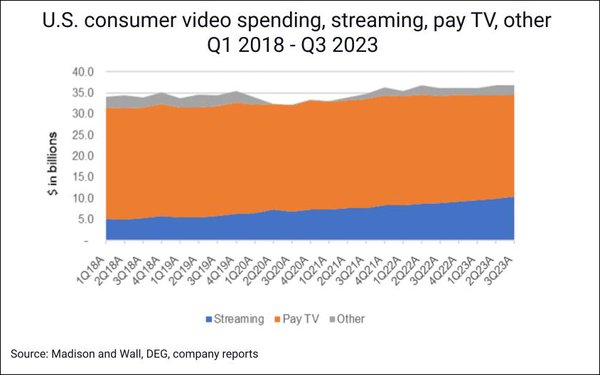Wieser: Streaming Price Hikes May Be Working Against Pay TV
- by Karlene Lukovitz @KLmarketdaily, November 21, 2023

If traditional pay-TV
services were hoping that the subscription price hikes by the leading streaming services would send consumers back to cable and satellite, it looks like they could instead be in for more bad news.
The difficulty of absorbing those streaming subscription price hikes actually may be contributing to further consumer cutbacks in pay-TV spending — a decidedly mixed
financial scenario for media companies still struggling to navigate the transition from traditional TV to streaming.
That’s the word from analyst Brian Wieser,
based on just-released Q3 data from Digital Entertainment Group, Amazon’s Box Office Mojo and his own estimates for spending on pay-TV services.
Reporting in his
Madison and Wall newsletter, Wieser estimates that overall spending on video at home and in theaters — pay TV, streaming and other — increased by 2% in the
quarter.
advertisement
advertisement
While overall growth is of course positive, Q3 also continued a trend of increased consumer spending on streaming and decreased spending on pay
TV.
Spend on streaming services grew 20.7% year-over-year — driven at least in part by price increases — while spending on traditional and virtual MVPDs
fell about 6% YoY, Wieser reports. In absolute terms, spending on pay TV fell by about $1.4 billion, while increased spending on streaming grew by $1.6 billion.
“Consumers may be cutting spending on traditional pay TV in order to fund spending on streaming,” he sums up.
“Growth in revenues from
streaming services is positive for the owners of those services, of course, and it’s the right thing to focus on for their overall businesses,” Wieser writes, but it is “also
important to consider that the profitability of streaming services will almost certainly never be comparable to traditional offerings,” due to higher costs to physically transmit content, higher
marketing costs, churn and the need to provide more substantive customer service.
“Even accounting for the fees that distributors take, I’m doubtful
that a dollar of revenue gained via streaming will ever produce the same amount of profit as a dollar paid to a distributor first,” Wieser continues.
“With
enough scale, a streaming service can produce more absolute profit than the traditional operations of a TV network, largely because it can be easier to expand globally. However, most of the US network
groups have retrenched from those efforts to at least some degree as they look to reduce near-term financial losses, leaving the field much more open for Netflix, Amazon and Apple to benefit from
scale with less intensive competition — and more long-term profitability — than might otherwise have been the case.”


